ESP TOYOTA COROLLA HATCHBACK 2020 Warranties & Maintenance Guides (in English)
[x] Cancel search | Manufacturer: TOYOTA, Model Year: 2020, Model line: COROLLA HATCHBACK, Model: TOYOTA COROLLA HATCHBACK 2020Pages: 260, PDF Size: 8.54 MB
Page 116 of 260
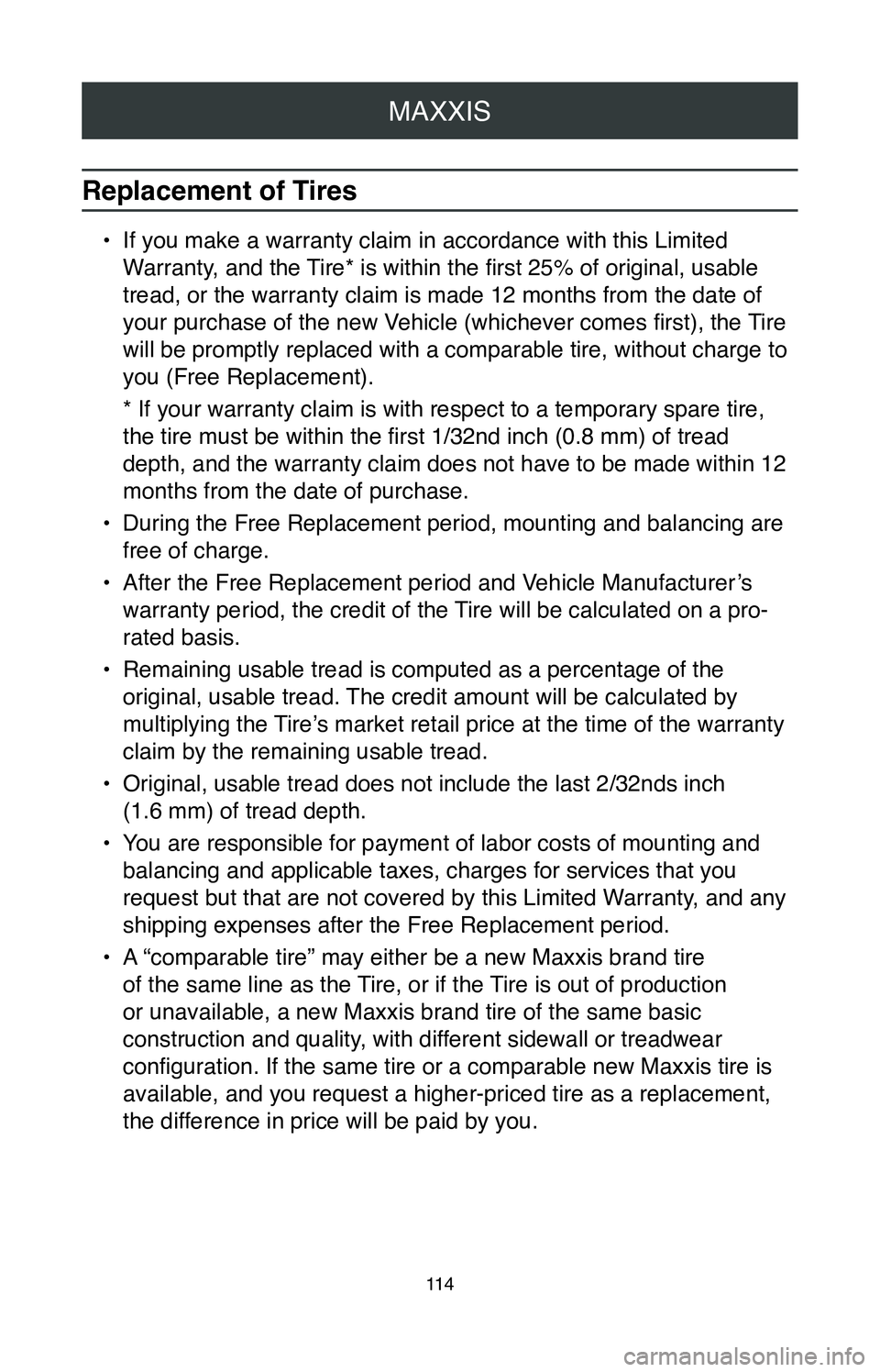
MAXXIS
11 4
Replacement of Tires
• If you make a warranty claim in accordance with this Limited
Warranty, and the Tire* is within the first 25% of original, usable
tread, or the warranty claim is made 12 months from the date of
your purchase of the new Vehicle (whichever comes first), the Tire
will be promptly replaced with a comparable tire, without charge to
you (Free Replacement).
* If your warranty claim is with respect to a temporary spare tire,
the tire must be within the first 1/32nd inch (0.8 mm) of tread
depth, and the warranty claim does not have to be made within 12
months from the date of purchase.
•
During the Free Replacement period, mounting and balancing are
free of charge.
•
After the Free Replacement period and Vehicle Manufacturer’s
warranty period, the credit of the Tire will be calculated on a pro-
rated basis.
•
Remaining usable tread is computed as a percentage of the
original, usable tread. The credit amount will be calculated by
multiplying the Tire’s market retail price at the time of the warranty
claim by the remaining usable tread.
•
Original, usable tread does not include the last 2/32nds inch
(1.6 mm) of tread depth.
•
You are responsible for payment of labor costs of mounting and
balancing and applicable taxes, charges for services that you
request but that are not covered by this Limited Warranty, and any
shipping expenses after the Free Replacement period.
•
A “comparable tire” may either be a new Maxxis brand tire
of the same line as the Tire, or if the Tire is out of production
or unavailable, a new Maxxis brand tire of the same basic
construction and quality, with different sidewall or treadwear
configuration. If the same tire or a comparable new Maxxis tire is
available, and you request a higher-priced tire as a replacement,
the difference in price will be paid by you.
Page 121 of 260
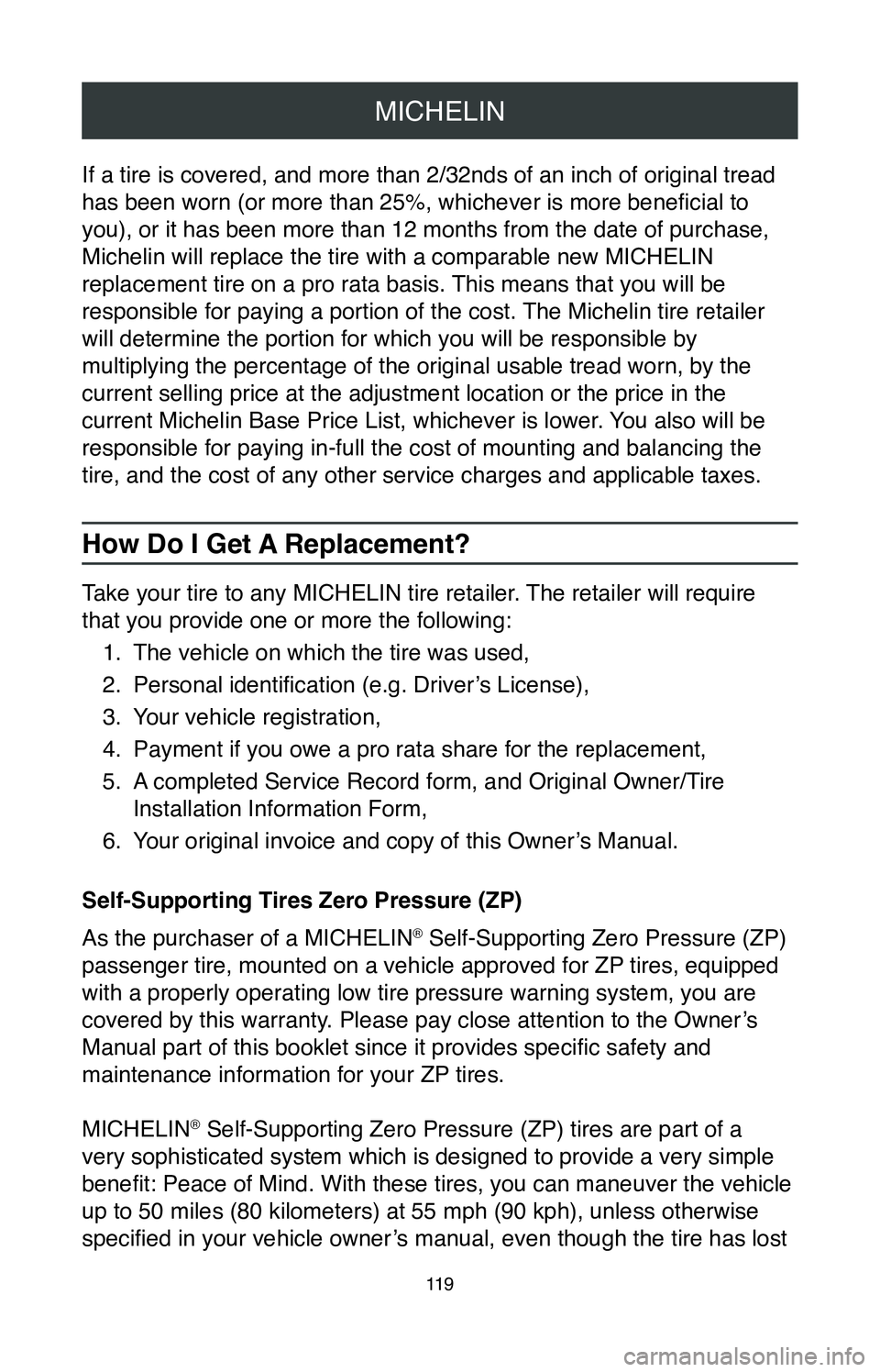
MICHELIN
11 9
If a tire is covered, and more than 2/32nds of an inch of original tread\
has been worn (or more than 25%, whichever is more beneficial to
you), or it has been more than 12 months from the date of purchase,
Michelin will replace the tire with a comparable new MICHELIN
replacement tire on a pro rata basis. This means that you will be
responsible for paying a portion of the cost. The Michelin tire retailer
will determine the portion for which you will be responsible by
multiplying the percentage of the original usable tread worn, by the
current selling price at the adjustment location or the price in the
current Michelin Base Price List, whichever is lower. You also will be
responsible for paying in-full the cost of mounting and balancing the
tire, and the cost of any other service charges and applicable taxes.
How Do I Get A Replacement?
Take your tire to any MICHELIN tire retailer. The retailer will require
that you provide one or more the following:1.
The vehicle on which the tire was used,
2.
Personal identification (e.g. Driver’s License),
3.
Your vehicle registration,
4.
Payment if you owe a pro rata share for the replacement,
5.
A completed Service Record form, and Original Owner/Tire
Installation Information Form,
6.
Your original invoice and copy of this Owner’s Manual.
Self-Supporting Tires Zero Pressure (ZP)
As the purchaser of a MICHELIN
® Self-Supporting Zero Pressure (ZP)
passenger tire, mounted on a vehicle approved for ZP tires, equipped
with a properly operating low tire pressure warning system, you are
covered by this warranty. Please pay close attention to the Owner’s
Manual part of this booklet since it provides specific safety and
maintenance information for your ZP tires.
MICHELIN
® Self-Supporting Zero Pressure (ZP) tires are part of a
very sophisticated system which is designed to provide a very simple
benefit: Peace of Mind. With these tires, you can maneuver the vehicle
up to 50 miles (80 kilometers) at 55 mph (90 kph), unless otherwise
specified in your vehicle owner’s manual, even though the tire has lost
Page 122 of 260

MICHELIN
120
all air! That means time to exit from the highway and get to a place
where the tire can be inspected, replaced, or possibly returned to
service. The distance that can safely be travelled following an air loss
incident will depend upon the conditions under which the vehicle is
operating, the degree of air loss, the extent of the damage causing the \
air loss, the ambient temperature, the load, and the operating speed
of the vehicle. The fewer miles you travel after an air loss incident, the
greater the likelihood that the tire can be re-inflated (or, if punctured,
repaired) and returned to service.
Michelin Tires with the Acoustic Logo Michelin tires with the Acoustic logo are covered
under this warranty. These tires are treated with
acoustic foam, and have specific instructions for repair
by tire professionals at Michelin authorized dealers.
Michelin Tires with the Self-Seal Logo
Michelin tires with the Self-Seal logo are covered
under this warranty. These tires are designed to seal
in the event of a puncture, and have specific
instructions for repair by tire professionals at Michelin
authorized dealers.
What Conditions And Exclusions Apply?
This warranty does not provide compensation for loss of time, loss of
use of vehicle, inconvenience or consequential damage. Some states
do not allow the exclusion or limitation of incidental or consequential \
damages, so these limitations or exclusions may not apply to you.
This warranty limits the length of all express and implied claims. Some \
states do not allow limitations on how long an implied warranty lasts,
so this limitation may not apply to you.
Tires presented for claim remain the property of the consumer, and
Michelin is not responsible for loss of or damage to tires which are
in the custody or control of a Michelin tire retailer for the purpose of\
inspection for warranty claims. In the event of a disputed claim, the
Page 124 of 260
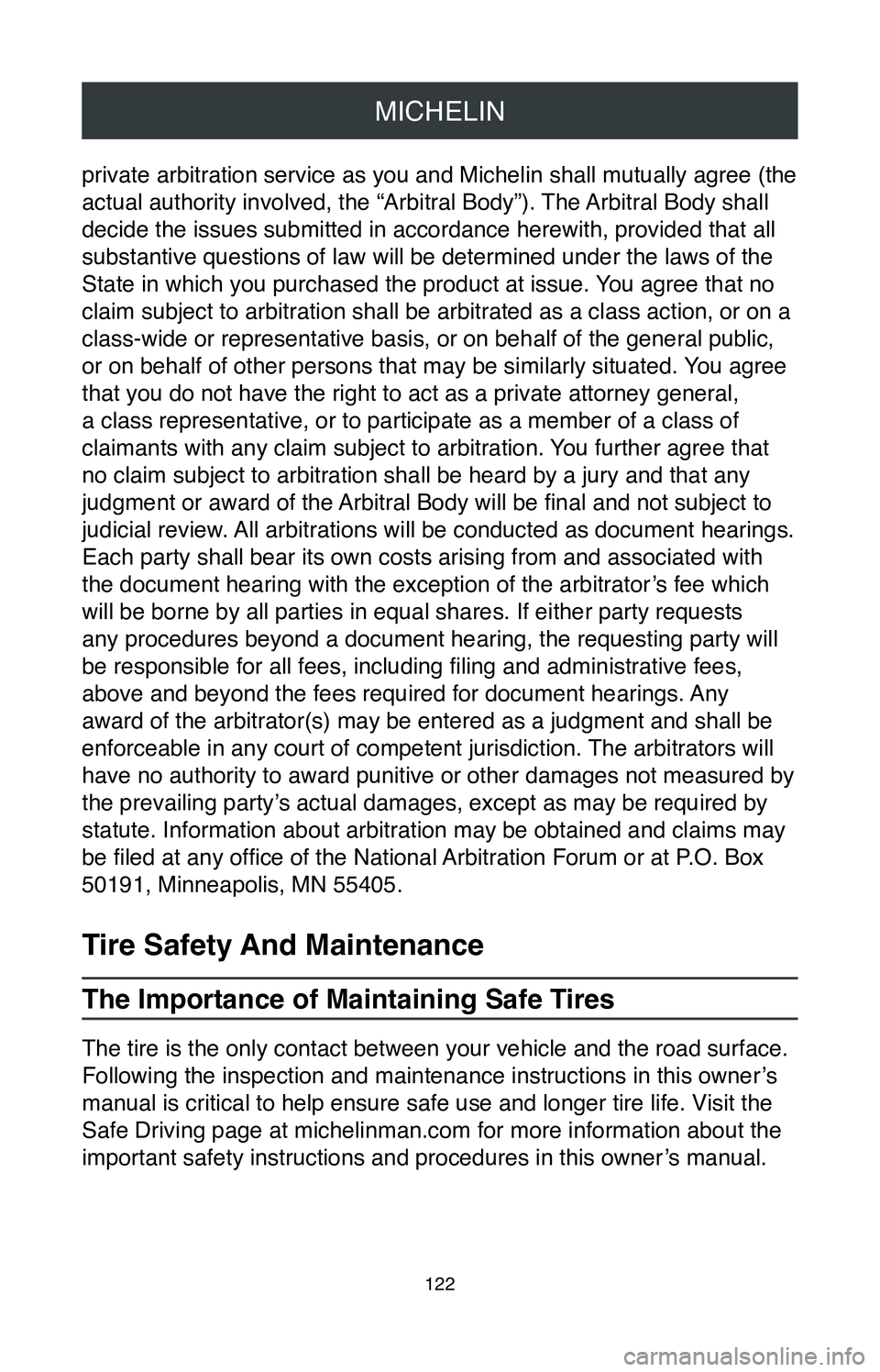
MICHELIN
122
private arbitration service as you and Michelin shall mutually agree (the
actual authority involved, the “Arbitral Body”). The Arbitral Body shall
decide the issues submitted in accordance herewith, provided that all
substantive questions of law will be determined under the laws of the
State in which you purchased the product at issue. You agree that no
claim subject to arbitration shall be arbitrated as a class action, or on a
class-wide or representative basis, or on behalf of the general public,
or on behalf of other persons that may be similarly situated. You agree
that you do not have the right to act as a private attorney general,
a class representative, or to participate as a member of a class of
claimants with any claim subject to arbitration. You further agree that
no claim subject to arbitration shall be heard by a jury and that any
judgment or award of the Arbitral Body will be final and not subject to
judicial review. All arbitrations will be conducted as document hearings.
Each party shall bear its own costs arising from and associated with
the document hearing with the exception of the arbitrator’s fee which
will be borne by all parties in equal shares. If either party requests
any procedures beyond a document hearing, the requesting party will
be responsible for all fees, including filing and administrative fees,
above and beyond the fees required for document hearings. Any
award of the arbitrator(s) may be entered as a judgment and shall be
enforceable in any court of competent jurisdiction. The arbitrators will
have no authority to award punitive or other damages not measured by
the prevailing party’s actual damages, except as may be required by
statute. Information about arbitration may be obtained and claims may
be filed at any office of the National Arbitration Forum or at P.O. Box
50191, Minneapolis, MN 55405.
Tire Safety And Maintenance
The Importance of Maintaining Safe Tires
The tire is the only contact between your vehicle and the road surface. \
Following the inspection and maintenance instructions in this owner’s
manual is critical to help ensure safe use and longer tire life. Visit the
Safe Driving page at michelinman.com for more information about the
important safety instructions and procedures in this owner’s manual.
Page 129 of 260
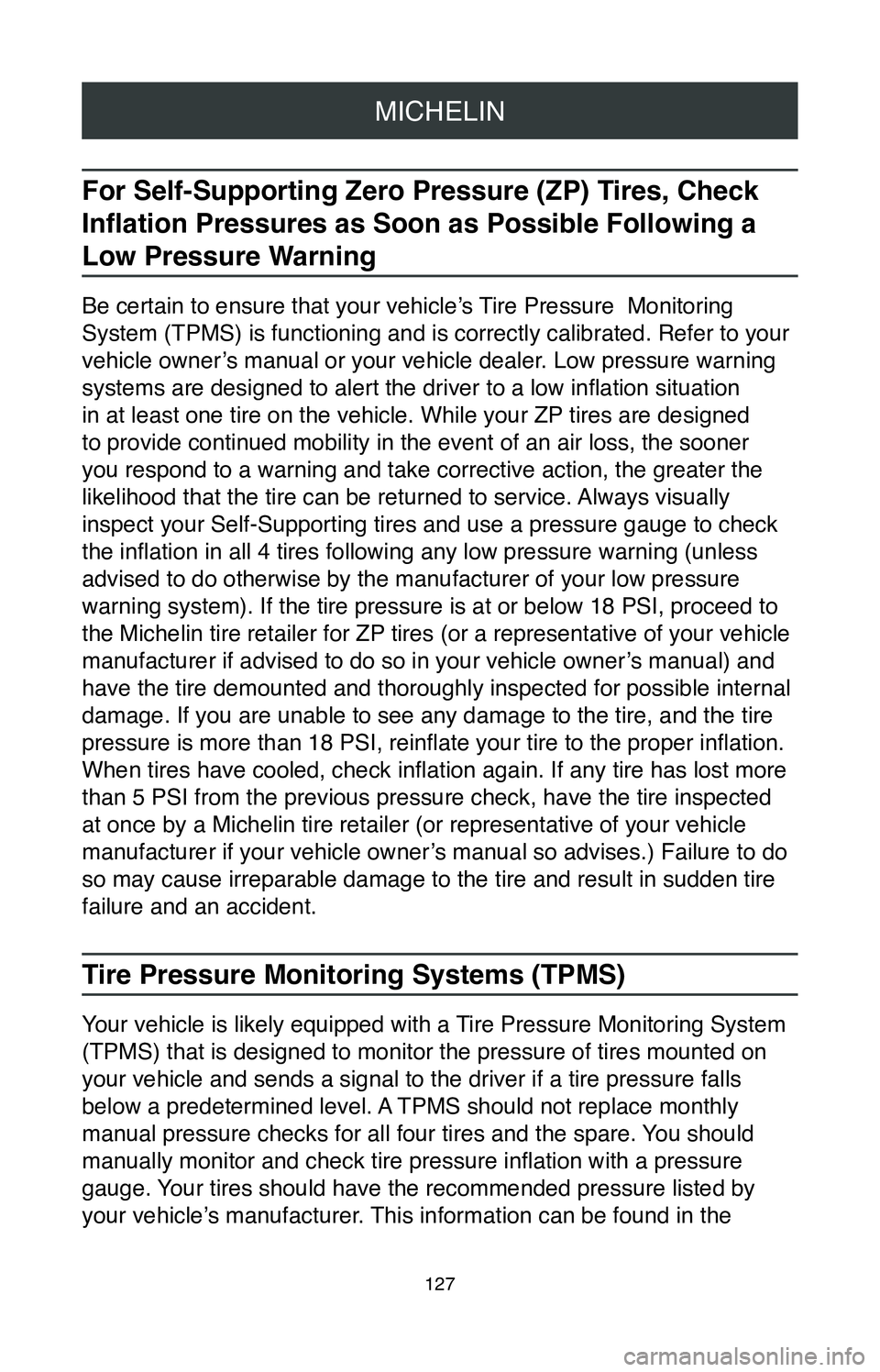
MICHELIN
127
For Self-Supporting Zero Pressure (ZP) Tires, Check
Inflation Pressures as Soon as Possible Following a
Low Pressure Warning
Be certain to ensure that your vehicle’s Tire Pressure Monitoring
System (TPMS) is functioning and is correctly calibrated. Refer to your
vehicle owner’s manual or your vehicle dealer. Low pressure warning
systems are designed to alert the driver to a low inflation situation
in at least one tire on the vehicle. While your ZP tires are designed
to provide continued mobility in the event of an air loss, the sooner
you respond to a warning and take corrective action, the greater the
likelihood that the tire can be returned to service. Always visually
inspect your Self-Supporting tires and use a pressure gauge to check
the inflation in all 4 tires following any low pressure warning (unless
advised to do otherwise by the manufacturer of your low pressure
warning system). If the tire pressure is at or below 18 PSI, proceed to\
the Michelin tire retailer for ZP tires (or a representative of your vehicle
manufacturer if advised to do so in your vehicle owner’s manual) and
have the tire demounted and thoroughly inspected for possible internal
damage. If you are unable to see any damage to the tire, and the tire
pressure is more than 18 PSI, reinflate your tire to the proper inflation.
When tires have cooled, check inflation again. If any tire has lost more
than 5 PSI from the previous pressure check, have the tire inspected
at once by a Michelin tire retailer (or representative of your vehicle
manufacturer if your vehicle owner’s manual so advises.) Failure to do
so may cause irreparable damage to the tire and result in sudden tire
failure and an accident.
Tire Pressure Monitoring Systems (TPMS)
Your vehicle is likely equipped with a Tire Pressure Monitoring System
(TPMS) that is designed to monitor the pressure of tires mounted on
your vehicle and sends a signal to the driver if a tire pressure falls
below a predetermined level. A TPMS should not replace monthly
manual pressure checks for all four tires and the spare. You should
manually monitor and check tire pressure inflation with a pressure
gauge. Your tires should have the recommended pressure listed by
your vehicle’s manufacturer. This information can be found in the
Page 130 of 260
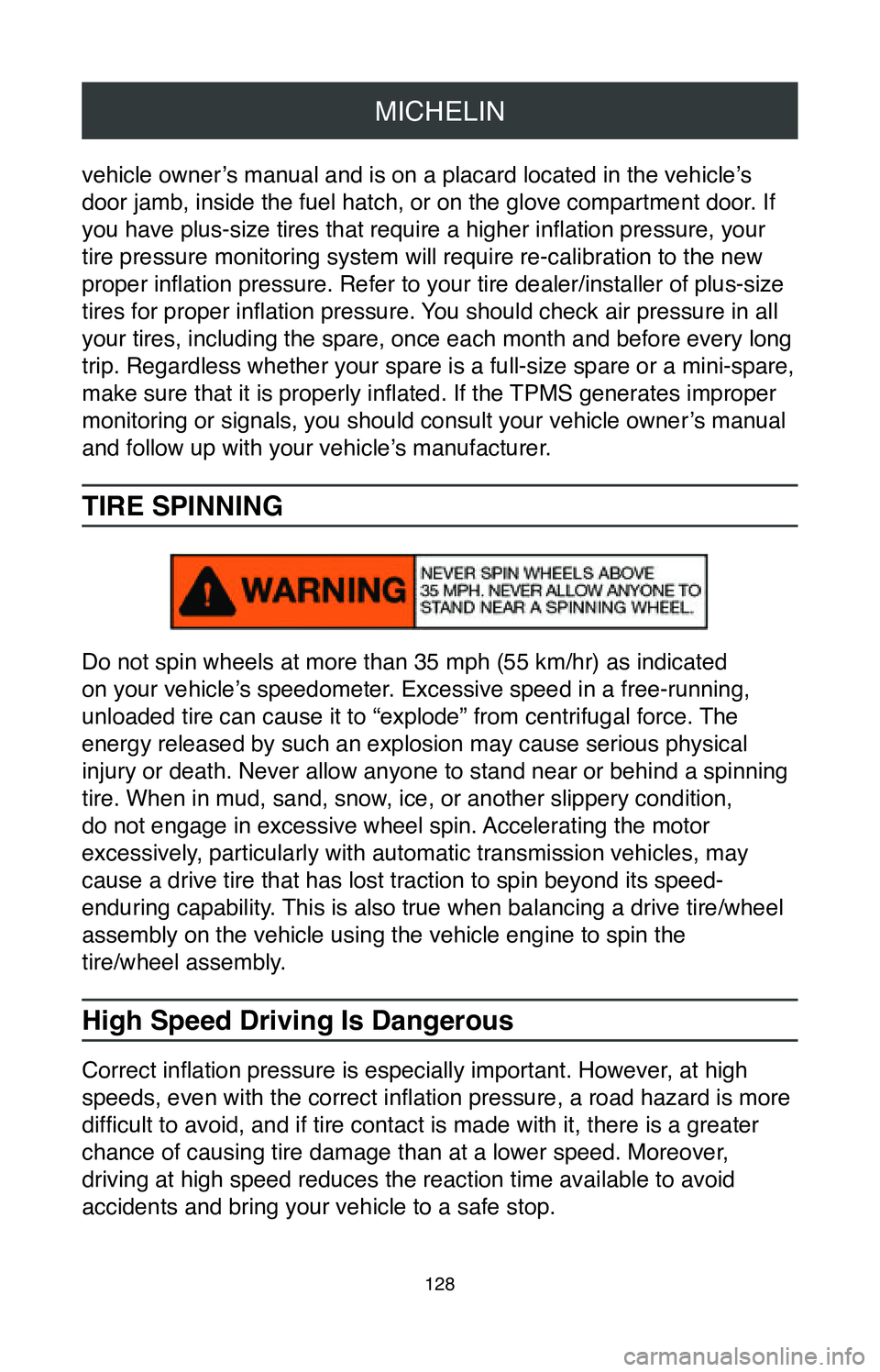
MICHELIN
128
vehicle owner’s manual and is on a placard located in the vehicle’s
door jamb, inside the fuel hatch, or on the glove compartment door. If
you have plus-size tires that require a higher inflation pressure, your
tire pressure monitoring system will require re-calibration to the new
proper inflation pressure. Refer to your tire dealer/installer of plus-size
tires for proper inflation pressure. You should check air pressure in all
your tires, including the spare, once each month and before every long
trip. Regardless whether your spare is a full-size spare or a mini-spare,
make sure that it is properly inflated. If the TPMS generates improper
monitoring or signals, you should consult your vehicle owner’s manual
and follow up with your vehicle’s manufacturer.
TIRE SPINNING
Do not spin wheels at more than 35 mph (55 km/hr) as indicated
on your vehicle’s speedometer. Excessive speed in a free-running,
unloaded tire can cause it to “explode” from centrifugal force. The
energy released by such an explosion may cause serious physical
injury or death. Never allow anyone to stand near or behind a spinning
tire. When in mud, sand, snow, ice, or another slippery condition,
do not engage in excessive wheel spin. Accelerating the motor
excessively, particularly with automatic transmission vehicles, may
cause a drive tire that has lost traction to spin beyond its speed-
enduring capability. This is also true when balancing a drive tire/wheel
assembly on the vehicle using the vehicle engine to spin the
tire/wheel assembly.
High Speed Driving Is Dangerous
Correct inflation pressure is especially important. However, at high
speeds, even with the correct inflation pressure, a road hazard is more
difficult to avoid, and if tire contact is made with it, there is a greater
chance of causing tire damage than at a lower speed. Moreover,
driving at high speed reduces the reaction time available to avoid
accidents and bring your vehicle to a safe stop.
Page 131 of 260

MICHELIN
129
Exceeding the maximum speeds shown on the following page for each
type of MICHELIN® tire will cause the tire to build up excessive heat,
which can cause tire damage that could result in sudden tire failure
and rapid air loss. Failure to control a vehicle when one or more tires \
experience a rapid air loss can lead to an accident.
In any case, you should not exceed reasonable speeds as indicated by
the legal limits and driving conditions.
Speed Rating System
The speed rating of a tire indicates the
speed category (or range of v speeds)
at which the tire can carry a load under
specified service conditions. The speed
rating system used today was developed
in Europe in response to the need to
categorize tires into standardized speeds.
A letter from A to Z symbolizes a tire’s
certified speed rating, ranging from 5 km/
hr (3 mph) to above 300 km/ hr (186
mph). This rating system (see chart on
this page) describes the top speed for
which a tire is certified.
When this speed rating system was originally developed, the
Unlimited V category of over 210 km/hr (130 mph) was the top speed
rating a tire could achieve. As manufacturers made more tires that fit
into this category, it was necessary to better regulate performance at
standardized speeds to help ensure safety. The Limited V category of
240 km/hr (149 mph) was then created, and the Z or (Y) speed rating
was added as the top speed rating that a tire could achieve. W and Y
limited speed symbols have been added as higher speed categories.
Always consult the tire manufacturer for the maximum speed of
Page 133 of 260
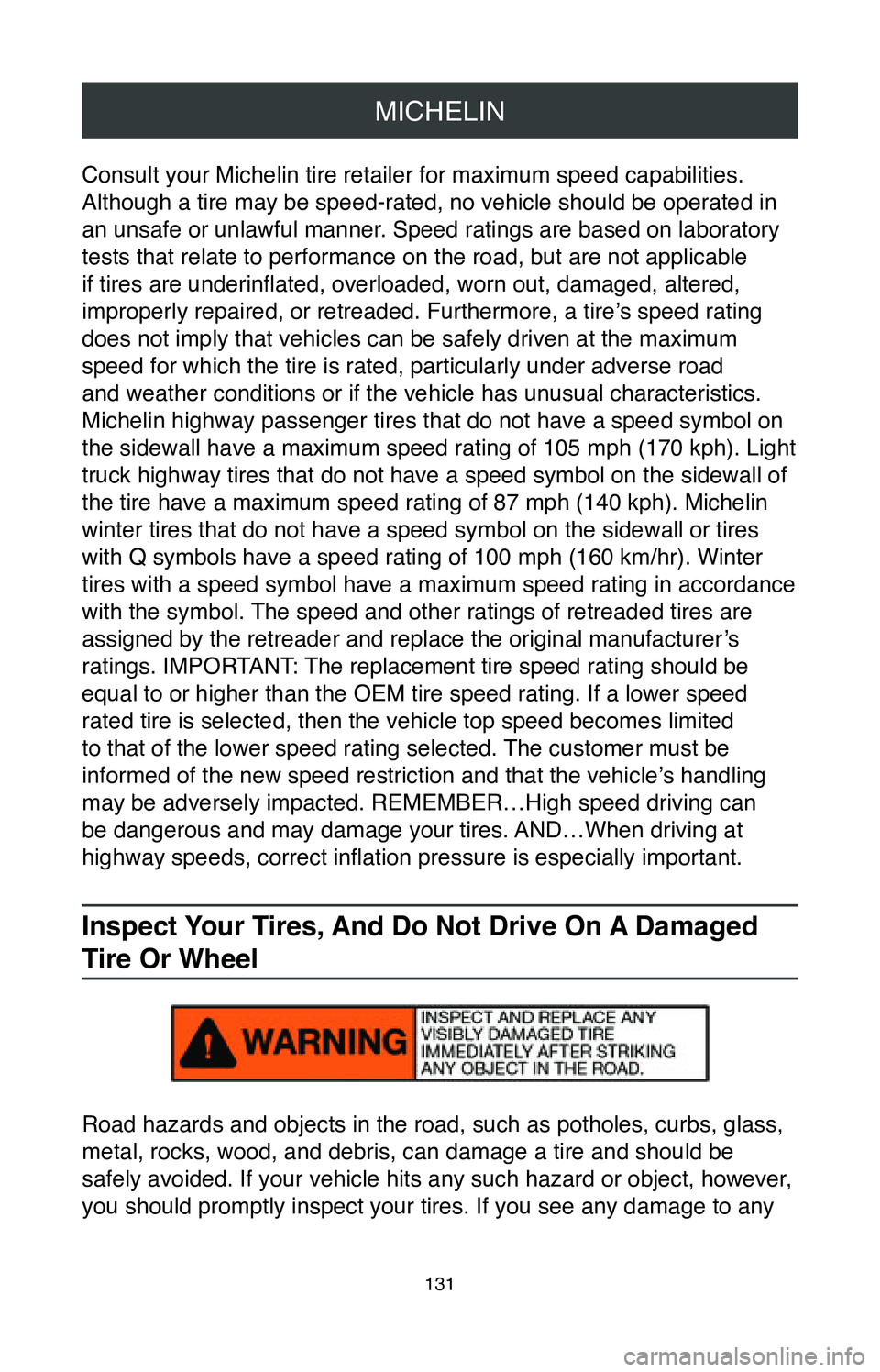
MICHELIN
131
Consult your Michelin tire retailer for maximum speed capabilities.
Although a tire may be speed-rated, no vehicle should be operated in
an unsafe or unlawful manner. Speed ratings are based on laboratory
tests that relate to performance on the road, but are not applicable
if tires are underinflated, overloaded, worn out, damaged, altered,
improperly repaired, or retreaded. Furthermore, a tire’s speed rating
does not imply that vehicles can be safely driven at the maximum
speed for which the tire is rated, particularly under adverse road
and weather conditions or if the vehicle has unusual characteristics.
Michelin highway passenger tires that do not have a speed symbol on
the sidewall have a maximum speed rating of 105 mph (170 kph). Light
truck highway tires that do not have a speed symbol on the sidewall of
the tire have a maximum speed rating of 87 mph (140 kph). Michelin
winter tires that do not have a speed symbol on the sidewall or tires
with Q symbols have a speed rating of 100 mph (160 km/hr). Winter
tires with a speed symbol have a maximum speed rating in accordance
with the symbol. The speed and other ratings of retreaded tires are
assigned by the retreader and replace the original manufacturer’s
ratings. IMPORTANT: The replacement tire speed rating should be
equal to or higher than the OEM tire speed rating. If a lower speed
rated tire is selected, then the vehicle top speed becomes limited
to that of the lower speed rating selected. The customer must be
informed of the new speed restriction and that the vehicle’s handling
may be adversely impacted. REMEMBER…High speed driving can
be dangerous and may damage your tires. AND…When driving at
highway speeds, correct inflation pressure is especially important.
Inspect Your Tires, And Do Not Drive On A Damaged
Tire Or Wheel
Road hazards and objects in the road, such as potholes, curbs, glass,
metal, rocks, wood, and debris, can damage a tire and should be
safely avoided. If your vehicle hits any such hazard or object, however,
you should promptly inspect your tires. If you see any damage to any
Page 137 of 260
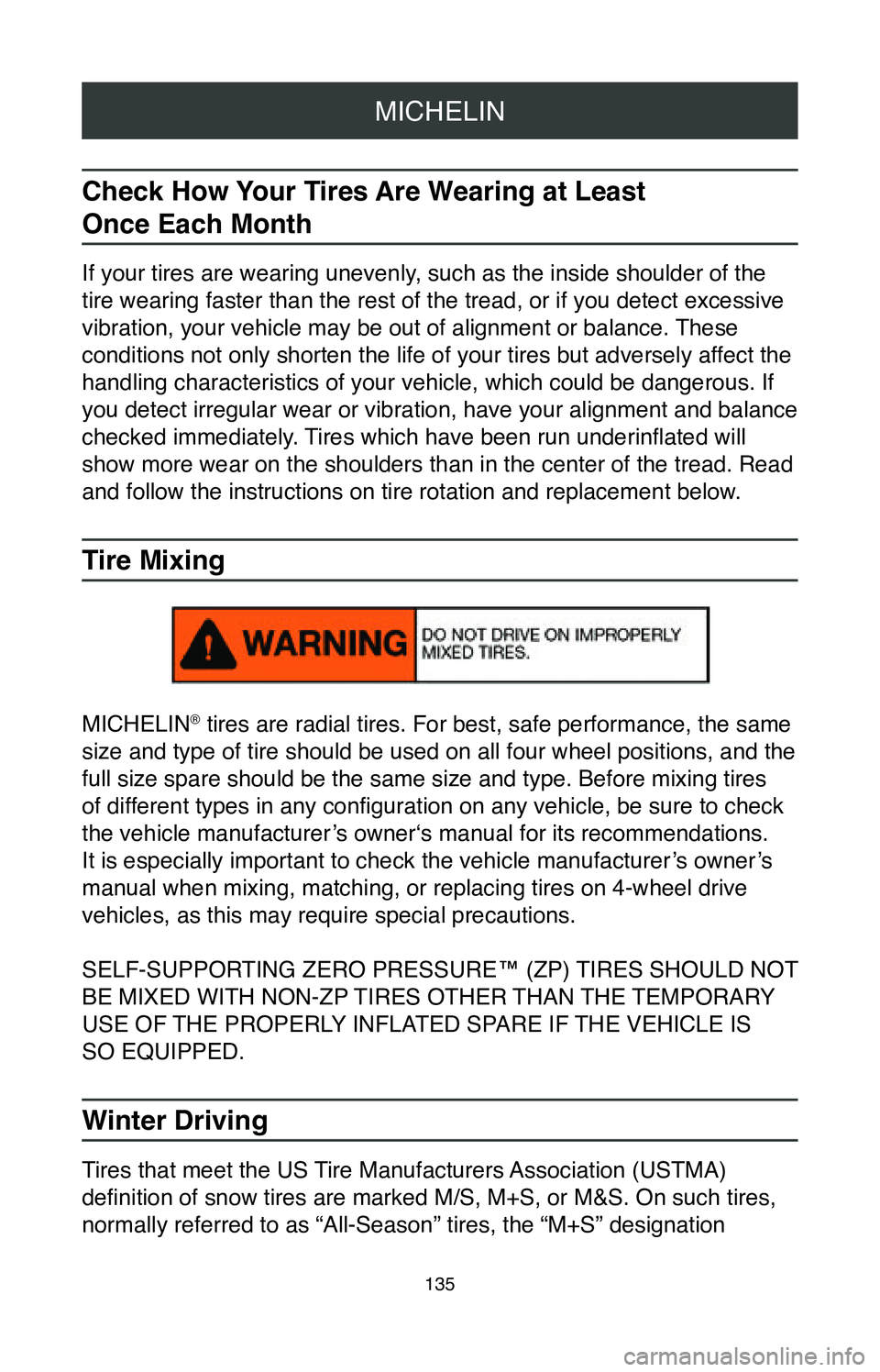
MICHELIN
135
Check How Your Tires Are Wearing at Least
Once Each Month
If your tires are wearing unevenly, such as the inside shoulder of the
tire wearing faster than the rest of the tread, or if you detect excessi\
ve
vibration, your vehicle may be out of alignment or balance. These
conditions not only shorten the life of your tires but adversely affect the
handling characteristics of your vehicle, which could be dangerous. If
you detect irregular wear or vibration, have your alignment and balance
checked immediately. Tires which have been run underinflated will
show more wear on the shoulders than in the center of the tread. Read
and follow the instructions on tire rotation and replacement below.
Tire Mixing
MICHELIN® tires are radial tires. For best, safe performance, the same
size and type of tire should be used on all four wheel positions, and th\
e
full size spare should be the same size and type. Before mixing tires
of different types in any configuration on any vehicle, be sure to check
the vehicle manufacturer’s owner‘s manual for its recommendations.
It is especially important to check the vehicle manufacturer’s owner’s
manual when mixing, matching, or replacing tires on 4-wheel drive
vehicles, as this may require special precautions.
SELF-SUPPORTING ZERO PRESSURE™ (ZP) TIRES SHOULD NOT
BE MIXED WITH NON-ZP TIRES OTHER THAN THE TEMPORARY
USE OF THE PROPERLY INFLATED SPARE IF THE VEHICLE IS
SO EQUIPPED.
Winter Driving
Tires that meet the US Tire Manufacturers Association (USTMA)
definition of snow tires are marked M/S, M+S, or M&S. On such tires,
normally referred to as “All-Season” tires, the “M+S” designation
Page 142 of 260
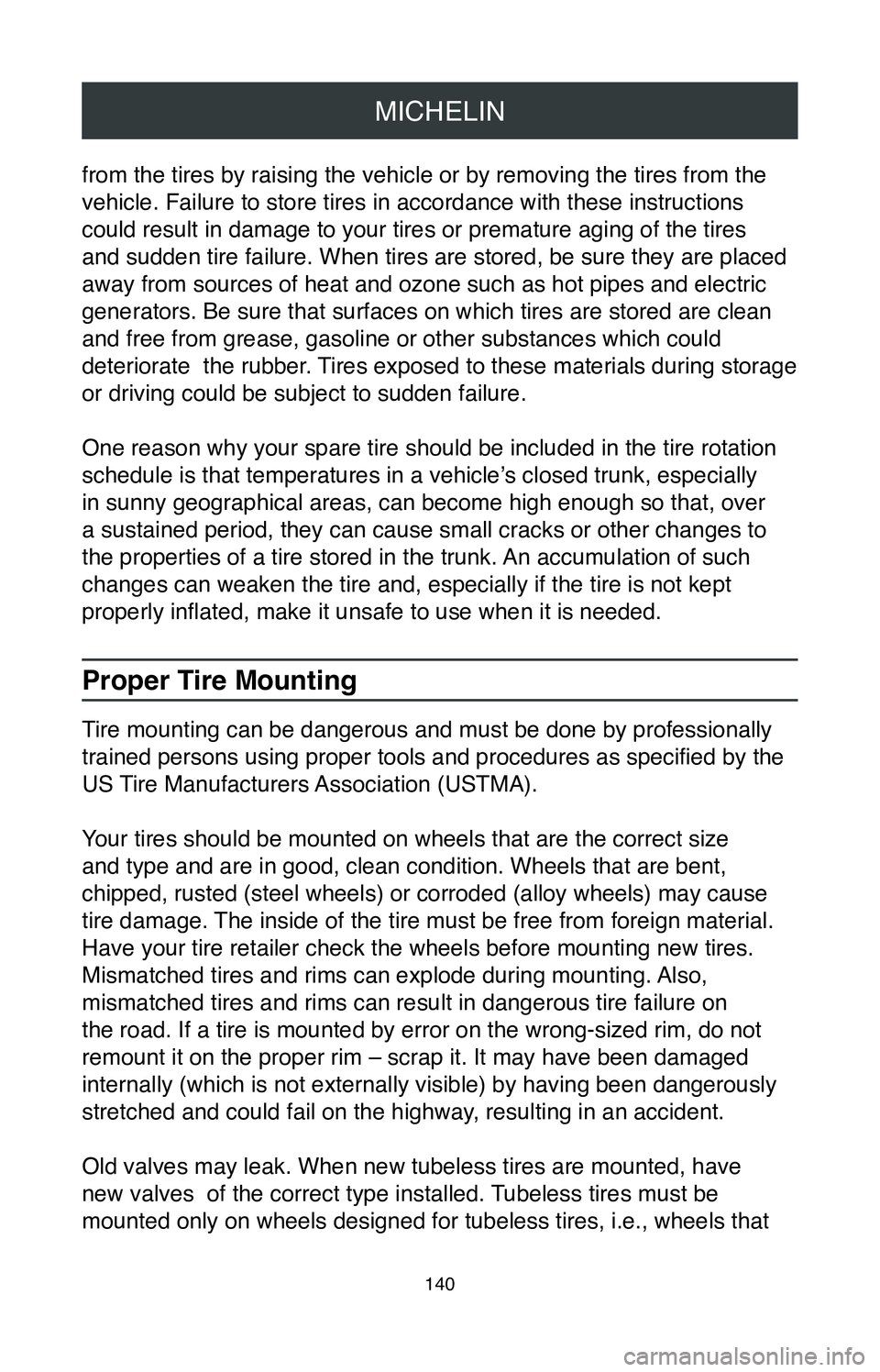
MICHELIN
140
from the tires by raising the vehicle or by removing the tires from the \
vehicle. Failure to store tires in accordance with these instructions
could result in damage to your tires or premature aging of the tires
and sudden tire failure. When tires are stored, be sure they are placed \
away from sources of heat and ozone such as hot pipes and electric
generators. Be sure that surfaces on which tires are stored are clean
and free from grease, gasoline or other substances which could
deteriorate the rubber. Tires exposed to these materials during storage
or driving could be subject to sudden failure.
One reason why your spare tire should be included in the tire rotation
schedule is that temperatures in a vehicle’s closed trunk, especially
in sunny geographical areas, can become high enough so that, over
a sustained period, they can cause small cracks or other changes to
the properties of a tire stored in the trunk. An accumulation of such
changes can weaken the tire and, especially if the tire is not kept
properly inflated, make it unsafe to use when it is needed.
Proper Tire Mounting
Tire mounting can be dangerous and must be done by professionally
trained persons using proper tools and procedures as specified by the
US Tire Manufacturers Association (USTMA).
Your tires should be mounted on wheels that are the correct size
and type and are in good, clean condition. Wheels that are bent,
chipped, rusted (steel wheels) or corroded (alloy wheels) may cause
tire damage. The inside of the tire must be free from foreign material.
Have your tire retailer check the wheels before mounting new tires.
Mismatched tires and rims can explode during mounting. Also,
mismatched tires and rims can result in dangerous tire failure on
the road. If a tire is mounted by error on the wrong-sized rim, do not
remount it on the proper rim – scrap it. It may have been damaged
internally (which is not externally visible) by having been dangerously
stretched and could fail on the highway, resulting in an accident.
Old valves may leak. When new tubeless tires are mounted, have
new valves of the correct type installed. Tubeless tires must be
mounted only on wheels designed for tubeless tires, i.e., wheels that